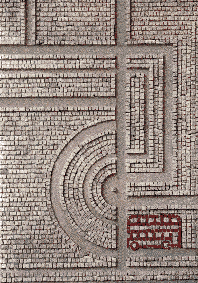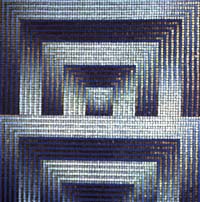
 |

THE COLOURS OF LIGHTFor more than a century, to mosaicists and architects all over the world the name Orsoni has meant smalti and gold tesserae. On November 28th, 1996, devotees gathered at the Orsoni factory in Venice to launch a book celebrating the famous firm. Peter Fischer, the mosaic historian, was there, and this is an edited version of the speech he gave. THE UNKNOWN ART OF MODERN MOSAIC "Perhaps it is useful to stress a fact which I have touched on only briefly in the book we are here to launch this evening, namely, the strange phenomenon that very few people, even among those who are interested in art, are aware that mosaic is an art which is still alive, indeed very much alive, in the 20th century. I have at home a letter written to me a number of years ago by the arts councillor of one of the principal German cities, informing me that mosaic was just a craft without any artistic importance. This is an attitude very similar to that of the general public towards modern mosaic and, alas, of many authorities and others who commission buildings. When, in the late sixties, I was preparing my complete history of mosaic, from the Sumerians to the present time, I found heaps of books on the mosaics of the Graeco-Roman and mediaeval-Byzantine periods, on all phases, all sites, all monuments. On the other hand, there was next to nothing on mosaic's development after the Renaissance; perhaps the odd article in some journal; maybe two or three books, more or less out of date. However, I was already aware that there really were mosaics made in the 19th and 20th centuries. In Ravenna I had seen some quite recent panels in various modern styles, but nearly all of them were based on designs by painters, and that is not what I call "autonomous mosaic"; a term by which I mean a mosaic which is independent of the rather different art of painting, one whose designer is also its physical maker, or at least has had a hand personally in its realization. The separation between these two - the practising mosaicist, and the painter-designer who is used to the techniques of the brush but is not familiar with the quite different stylistic requirements and possibilities of mosaic - this separation was the principal cause of the decline of mosaic after the Renaissance. After seeing these and other examples of modern mosaics I made efforts to expand my research, writing letters in all directions, visiting mosaicists and their studios, schools and monuments in various European countries, in Tunisia and America, as well as factories where tesserae are produced, such as Orsoni's and the Vatican. Artists visited me in London: from England, Germany, Belgium, the United States, Nigeria, New Zealand, Japan. The late Rokuro Yabashi was, I believe, virtually the father of the art of mosaic in Japan, where it is now widespread. Indeed, there is abundant proof that mosaic is now more widespread than ever before, not just in Europe but all over the world, and this is why I find it so strange that so few people are aware of the simple and obvious fact that they can see modern mosaics in so many places of different kinds: no longer just in temples, churches, palaces and the villas of of bigshots and fat cats, but also in schools, sports establishments, swimming pools, hospitals, banks, hotels, railway stations, airports, office premises of every description. Mosaic is no longer just an ecclesiastic and aristocratic art; it has become democratic - and equally democratic and diverse are its subject matter and its styles.
So there can be no doubt that mosaic is not a has-been art which expired during the Renaissance, but that it has had a real rebirth. Nor can there be any doubt that contemporary mosaic is capable of being really and truly contemporary, and able to make use of the stylistic pluralism of 20th century art. The very ancient art of mosaic can also be very modern - the reason being that composition with small pieces of marble or glass or other less costly materials lends itself to simplification, to stylization, to shimmering spirituality. From the earliest beginnings mosaic has applied the principles of French pointillism and Italian divisionismo, of Op Art, of assemblage and montage, of objets trouv‚s. Indeed, as the quantity of mosaics today is without doubt much greater than ever, there is for me no doubt that the artistic quality of the best contemporary mosaics is at least equal to those of Antiquity and the Middle Ages - and I don't think I am sticking my neck out by saying "at least". Furthermore, mosaic has always been linked to architecture, strengthening as well as embellishing walls or floors; and modern architecture of the Bauhaus type, as well as the post-modern, offers plenty of surfaces for mosaic decorations. So it seems strange to me that, in spite of this, many mosaicists are forced to earn their daily bread by selling copies of old mosaics to tourists, or small practical objects of the type which in Italian is called oggettistica: things like coffee tables, mirror frames and such like, which can certainly be beautiful and artistic, but do not have the monumental grandeur of a great architectural mosaic - which, after all, is the true origin of the art of mosaic. Among the causes of this situation there are obviously economic problems, and the cause of these is often the strange phenomenon that many of those who might commission large mosaics are just not aware of the existence of contemporary mosaics of high artistic standard. So let me conclude by adapting old Cato's famous phrase: 'In my judgement, modern mosaic must be encouraged...'."
|
All
content is copyright of © Mosaic Matters and its contributors.
All rights reserved
Mosaic
Matters is:
Editor: Paul Bentley
Web Manager/Designer: Andy Mitchell

 I had also seen in London mosaics by my German
compatriot, the late Hans Unger. With Eberhard Schulze he had designed
and made Busabout, a true masterpiece of the art of mosaic, commissioned
by London Transport, printed as a poster and displayed in all the
tube stations. It is a monochrome mosaic, all white marble, all
abstract geometry, yet not entirely abstract, because it is also
a paradigm of the London map with its streets and characteristic
crescents. Ingeniously, the outlines are not rows of black tesserae
but white ones slightly protruding in relief, so that it is their
shadow which creates the outlines. In a corner there is one tiny
touch of colour, an elegant grace-note, a visual joke - a red London
bus. It is a mosaic of a standard of excellence similar to those
which Lucio Orsoni was to achieve later, but different, because
Lucio's monochromes are really polychromes made up of a vast scale
of different shades of a given colour, which the skill of his brother
Ruggero produces in such impressive varieties.
I had also seen in London mosaics by my German
compatriot, the late Hans Unger. With Eberhard Schulze he had designed
and made Busabout, a true masterpiece of the art of mosaic, commissioned
by London Transport, printed as a poster and displayed in all the
tube stations. It is a monochrome mosaic, all white marble, all
abstract geometry, yet not entirely abstract, because it is also
a paradigm of the London map with its streets and characteristic
crescents. Ingeniously, the outlines are not rows of black tesserae
but white ones slightly protruding in relief, so that it is their
shadow which creates the outlines. In a corner there is one tiny
touch of colour, an elegant grace-note, a visual joke - a red London
bus. It is a mosaic of a standard of excellence similar to those
which Lucio Orsoni was to achieve later, but different, because
Lucio's monochromes are really polychromes made up of a vast scale
of different shades of a given colour, which the skill of his brother
Ruggero produces in such impressive varieties.
